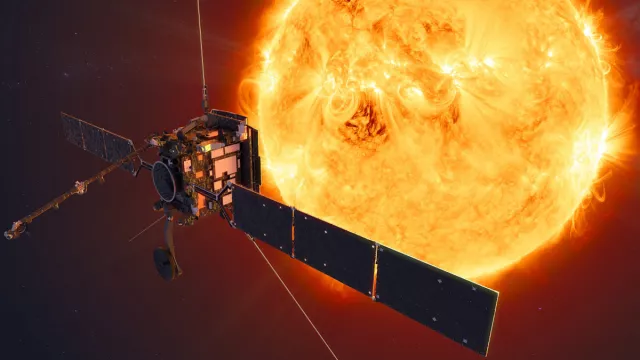The mission of the European Space Agency’s Solar Orbiter satellite is to study the Sun’s heliosphere and observe it in unprecedented detail in an attempt to unmask the secrets of the solar wind.
Key information
| Mission | Observe the Sun |
|---|---|
| Domain | Science |
| Launch date | 10 February 2020 |
| Partners | ESA, NASA, CNRS |
| Where | Elliptical orbit around the Sun with a perihelion of 42 million km and increasing inclination up to more than 30° with respect to the solar equator |
| Lifetime | 7½ years, with possible extension for a further 2.4 years |
| Status | In operation |
Key figures
- 42 million km at closest perihelion
- 70 km/pixel spatial resolution
- 10 instruments
- 1,800 kg: spacecraft mass
Key milestones
- 2 September 2030: 8th Venus gravity assist
- 10 June 2029: 7th Venus gravity assist
- 17 March 2028: 6th Venus gravity assist
- 24 December 2026: 5th Venus gravity
- 18 February 2025: 4th Venus gravity assist
- October 2022: Perihelion less than 0.3 AU
- 3 September 2022: 3rd Venus gravity assist
- 26 November 2021: Earth gravity assist
- 8 August 2021: 2nd Venus gravity assist
- February 2021: Perihelion less than 0.5 AU
- 27 December 2020: Venus gravity assist
- 15 June 2020: 1st perihelion 77 million km
- 31 May and 6 June 2020: Solar Orbiter flies through tail of comet C/2019 Y4 (ATLAS)
- 10 February 2020: Solar Orbiter launched by Atlas V from Kennedy Space Center
- September 2018: Spacecraft delivered for environmental testing in Germany
- April 2012: ESA selects Astrium UK to build spacecraft
- October 2011: ESA selects Solar Orbiter for its Cosmic Vision programme
- May 2008: ESA selects scientific instruments
- June 2004: ESA confirms mission for Horizon 2000+ programme
- October 2000: Solar Orbiter down-selected by ESA
Project in brief
In 2020, the Solar Orbiter satellite departed Earth atop an Atlas V launcher on a mission to approach the Sun to within 62 solar radii or 42 million kilometres, closer than any spacecraft has ever been before. From this vantage point, it will be ideally positioned to observe our star at unprecedented resolution (70 km/pixel) and analyse its heliosphere in fine detail.
Solar Orbiter will also acquire imagery and data from the Sun’s polar regions and on the side not visible from Earth. The main aim of these measurements will be to identify the underlying processes driving the solar wind, the stream of particles continuously escaping the Sun.
To accomplish this goal, Solar Orbiter will combine in-situ measurements in the satellite’s immediate environment with remote-sensing observations.
CNES’s role
Solar Orbiter is a mission of ESA’s Cosmic Vision 2015-2025 programme. ESA oversaw development of the satellite, which was launched by NASA. CNES was involved in building six of Solar Orbiter’s ten instruments. The agency supplied the RPW instrument in partnership with the LESIA space and astrophysics instrumentation research laboratory at the Observatoire de Paris.
Contacts
Solar Orbiter Project Leader, science data exploitation
Desi Raulin
E-mail: desi.raulin at cnes.fr
RPW Contract Manager (Development)
Eric Lorfèvre
E-mail: eric.lorfevre at cnes.fr
Sun, Heliosphere & Magnetospheres subject matter expert
Kader Amsif
E-mail: kader.amsif at cnes.fr


